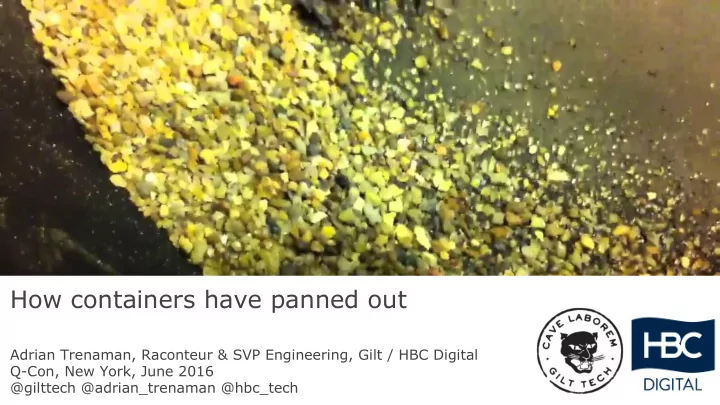

How containers have panned out Adrian Trenaman, Raconteur & SVP Engineering, Gilt / HBC Digital Q-Con, New York, June 2016 @gilttech @adrian_trenaman @hbc_tech
“What competitive advantage did containers give you?”
Gilt: luxury designer brands at discounted prices
we shoot the product in our studios
we receive, store, pick, pack and ship...
we sell every day at noon...
stampede...
this is what the stampede really looks like...
m > n This is fundamentally a packing problem. We have n machines, and we have m services to deploy.
1 It’s also an isolation problem Any given service / team / engineer shouldn’t be able to take out someone else’s work in production.
It’s also an impedance mismatch problem. Developers often think of machines as something that’s all theirs, magically provided by the hardware fairy.
LXC Leveraging LXC in Tokyo for Gilt Japan
Rack 1 Rack 1 Load Balancer Load Balancer 16xCPU, 128GB RAM, 900GB Disk. 20-40 C LXC 20-40 C LXC Ubuntu 12.04 (→ 16.04) 20-40 C LXC 20-40 C LXC ~220 C LXC in total. 20-40 C LXC 20-40 C LXC DB (C LXC ) DB (C LXC ) Email Email Email Email
LXC @ Gilt Japan ✔ Scalable, performant use of machine resources. ✔ Solves the impedance mismatch: developers see ‘a machine’ ✔ Limits the damage a single engineer can do. ✔ Infra/Devops engineer embedded into a tightly knit engineering team ❌ Static infrastructure ❌ Potential for resource hogging
Immutable Deployment With Docker
Prod Dark Canary Dark Canary Instance_0 Instance_0 Canary Instance_1 Instance_1 Instance_2 Instance_n 1.0.1 1.0.0 1.0.1 1.0.1 1.0.0 1.0.0 1.0.1 1.0.0 1.0.1 Core idea #1: dark canaries, canaries, release, roll-back.
Docker registry <<EC2 Instance>> docker <<container>> Core idea #2: One container per host / EC2 instance
Auto Scaling ION-Roller Group (ASG) Docker (orchestrates registry everything) Instance_0 - v1.0.0 Instance_1 - v1.0.0 Instance_2 - v1.0.0 Elastic Load Balancer (ELB) Auto Scaling Group (ASG) Instance_0 - v1.0.1 Instance_1 - v1.0.1 Instance_2 - v1.0.1 ION-Roller - https://github.com/gilt/ionroller
ION-Roller deployment: ✔ Immutable deployment :) ✔ DNS + ELB traffic migration :) ❌ Slow to set up / tear down environments :( ❌ Potentially expensive under continuous deployment :( ❌ Open-source, but in-house. ‘A snowflake in the making’ ❅
6 “We could solve this now, or, just wait six months, and Amazon will provide a solution” Andrey Kartashov, Distinguished Engineer, Gilt.
Instance_0 - v1.0.0 Live Traffic Instance_1 - v1.0.0 Instance_2 - v1.0.0 Elastic Load Balancer (ELB) http://hello-world-nova.common.giltaws.com Instance_3 - v1.0.0 Canary Elastic Load Dark Balancer (ELB) Instance_4 - v1.0.0 Canary http://hello-world-nova-dark.common.giltaws.com github.com/gilt/nova- deployment patterns
CloudFormation nova.yml $> nova stack create production CodeDeploy templates github.com/gilt/nova - creating environments
Instance_0 - v1.0.1 Instance_0 - v1.0.0 bundle S3 CodeDeploy Live Traffic Instance_1 - v1.0.0 Instance_1 - v1.0.1 Instance_2 - v1.0.1 Instance_2 - v1.0.0 Elastic Load Balancer (ELB) Instance_3 - v1.0.1 Instance_3 - v1.0.0 live Canary Elastic Load Dark Balancer (ELB) Instance_4 - v1.0.0 Instance_4 - v1.0.1 Canary dark $> nova deploy common Production $> nova deploy common DarkCanary $> nova deploy common Canary 1.0.1 1.0.1 1.0.1 github.com/gilt/nova- deployment
Nova deployment: ✔ No docker registry (shock! gasp!) :) ✔ Less boilerplate code :) ✔ Immutable deployment (on mutable infrastructure) :) ✔ Leverage AWS tooling :) ? Next up? Integrate with Code Pipeline :?
Fighting bit rot, chaos-monkey style With long running mutable AMIs, it’s possible for bit-rot to creep in. Think security vulnerability . Novel approach: every day, kill and restart your oldest AMI randomly. ✔ Pick up latest AMI with fixes ✔ Fail early, noisily and loudly if there’s a problem without a production outage. Vulnerability in container? Cut a new release against a fixed base-image.
Explorations in ECS
Sundial - running batch jobs with Docker & ECS ✔ Job dependencies (allows us to break large jobs into smaller jobs) ✔ Ease of viewing logs and debugging failures ✔ Automatic rescheduling of failed tasks within a job ✔ Isolation between jobs ✔ Low cost of setup and maintenance, as few moving parts as possible for Infra teams to manage http://github.com/gilt/sundial
Sundial: processes A process in Sundial is a grouping of tasks (jobs) with dependencies between them. Schedule : Either manually triggered, continuous schedule, or cron schedule Overlap strategy : if previous iteration hasn’t completed, do we Wait Terminate previous iteration Run in parallel When a process kicks off, all tasks with no dependencies kick off. When a task finishes, any tasks blocked by that task will kick off.
ECS is getting really attractive... We’re prototyping using for customer-facing services on our mobile team: ✔ Less configuration / moving parts than MST/Nova ✔ Automatic rollout ✔ Easy integration with IAM, CloudWatch, ECR But: ❌ IAM roles at instance level not container level ❌ Tension between CF stack templates and deployment updates ❌ ELBs require fixed ports: we want to define the listening port.
Docker as Build Platform
docker-machine Using docker as a docker local build platform The problem: keeping up Build Container with different versions / combinations of build tools is crazy hard. Why not use Docker for build, using a versioned build container?
Lesson #1 Containers have let us separate what we deploy (JVM, RoR, …) from how and where we deploy it (mst, nova, EC2, Triton) and This Is Good.
Lesson #2 It’s still a wild-west in terms of how containers are deployed. Different teams have different needs - be sensitive to that.
Lesson #3 Seek immutability in the container, not in the stack.
Lesson #4 The competitive advantage: containers let us deploy quickly, frequently and safely to production, which help us innovate faster. That’s it.
#thanks @adrian_trenaman @gilttech @hbc_tech
Recommend
More recommend